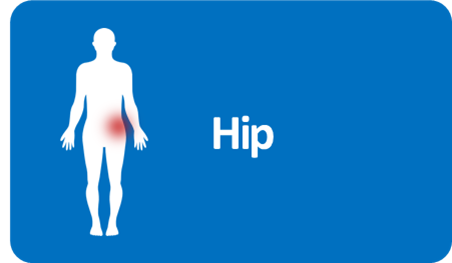Self help resources - Hip

Documents / Leaflets
Useful Sites
The following information has been written to help you fully self-manage your hip pain.
However, please self-refer straight away to be assessed by a Physiotherapist if you:
- Have had recent trauma to your hip and have a significant loss of movement/strength or noticeable swelling
- Constant day & night pain that you cannot settle
- You are off-sick and struggling to return to work due to your hip pain
- Have new hip or pelvic pain during a pregnancy that you a struggling to cope with
- Your symptoms are worsening and are not improving despite following advice below over the course of six weeks
If you have a history of cancer, immunodeficiency or TB and have new, unexplained and constant pain then please speak to your GP whilst you attempt the following self-help advice.
What can I do to help?
Hip pain is common and can be due to many different factors. Whatever the cause, it is important to exercise and maintain a healthy weight as best as possible. Hip can also be self-managed really effectively following some simple advice and exercises. If you are struggling with your pain, the following initial advice should help you to get started:
Pain relief: Basic painkillers (like paracetamol) or non-steroidal anti-inflammatory gels (such as Ibuleve/Voltarol) are easily available over the counter without the need for prescription. These can be very effective as they lessen your discomfort and importantly allow you to keep moving/active. However, please check the labels for instructions/safe usage and any possible reasons why you should not use them. If you are currently taking any form of medication it is advisable to consult your GP or Pharmacist before taking additional pain relief.
Heat or Ice: Heat is often useful for easing pain using a hot water bottle or wheat pack. Use for 15-20 minutes at a time and repeat several times a day as necessary. However, if you have had a recent injury or flare up you may find it more therapeutic to use an ice pack to reduce your pain/irritation. A packet of frozen peas wrapped in a tea-towel works well. Leave in place for up to 15 minutes at a time. Again, this can be repeated several times a day if found helpful.
Rest vs. activity: It is usually best to carry out your normal activities, but try not to overdo it. Let pain be your guide; short-lasting/temporary discomfort is fine but worsening or constant 24/7 pain indicates you are likely doing too much and need to take things a little easier. You need to pace yourself to start with and try to do a bit more each few days. You will find keeping your hip gently moving more comfortable than complete rest.
Exercise
Exercise can be an extremely beneficial treatment for your hip pain as it can gradually build the tolerance and load-capacity of your tissues and help ease stiffness and soreness. Hips can respond really well to gradual strengthening over the course of a few months.
Please try this exercise programme 1-2 times a day. A small increase in pain is OK if it goes away relatively quickly and not worse the next day. If you feel you have done too much, do not worry, do fewer repetitions the next time and then gradually build up again. It may take 5-6 weeks before you start to see improvement.
For a printable version of these exercises please click here
If your hip pain does not start to improve over the next 6 weeks or gets worse despite the exercises, then you can self-refer yourself to see a Physiotherapist for an assessment.
Exercises 1 – Bridging
Lie on you back with your knees bent and feet flat on the bed
Squeeze you bottom and curl your bottom off the bed keeping you back relaxed. Hold for 5 seconds then lower
Perform 5-10 repetitions aiming for eventual slight ache/fatigue


Exercises 2 – Standing Leg Raises
Stand tall holding on to support for balance
Lift your affected leg to the side and hold for 5 seconds before slowly lowering
Perform 5-10 repetitions aiming for eventual slight ache/fatigue


Optional Exercises 3 – Standing Squats
Hold on to something sturdy for support
Squat down slowly as far as comfortable then return to standing position
Perform 5-10 repetitions aiming for eventual slight ache/fatigue


Exercise 4 - Piriformis Stretch
Lie down on your back. Place your affected leg’s ankle on the opposite knee
Reach forwards and pull the good leg towards you until you feel a tolerable stretch in the affected side’s buttock. If is a struggle to reach then you could use a towel around the shin to pull instead.
Hold 30 seconds



Exercises 5 – Self Soft Tissue Massage
You may find it helpful to massage any tender soft tissue areas of you buttock using a tennis ball against a wall. Find the most tender spots and keep the pressure on until the associated pain fades (can take between 10-90 seconds). Then move to another area and repeat. Avoid pressing over the bony part of your lateral hip you will probably just find this irritable.
This will only give short lasting relief but can be used regularly to give you comfort whilst you progress with your hip strengthening programme. Stop simply if you find it aggravating.
You can use this a few times each week if you find it helpful.
